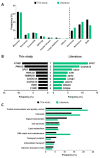NGS in Hereditary Ataxia: When Rare Becomes Frequent
- PMID: 34445196
- PMCID: PMC8395181
- DOI: 10.3390/ijms22168490
NGS in Hereditary Ataxia: When Rare Becomes Frequent
Abstract
The term hereditary ataxia (HA) refers to a heterogeneous group of neurological disorders with multiple genetic etiologies and a wide spectrum of ataxia-dominated phenotypes. Massive gene analysis in next-generation sequencing has entered the HA scenario, broadening our genetic and clinical knowledge of these conditions. In this study, we employed a targeted resequencing panel (TRP) in a large and highly heterogeneous cohort of 377 patients with a clinical diagnosis of HA, but no molecular diagnosis on routine genetic tests. We obtained a positive result (genetic diagnosis) in 33.2% of the patients, a rate significantly higher than those reported in similar studies employing TRP (average 19.4%), and in line with those performed using exome sequencing (ES, average 34.6%). Moreover, 15.6% of the patients had an uncertain molecular diagnosis. STUB1, PRKCG, and SPG7 were the most common causative genes. A comparison with published literature data showed that our panel would have identified 97% of the positive cases reported in previous TRP-based studies and 92% of those diagnosed by ES. Proper use of multigene panels, when combined with detailed phenotypic data, seems to be even more efficient than ES in clinical practice.
Keywords: Genesis; HA; TRP; cohort; diagnostic yield; exome sequencing; mutation; next-generation sequencing; targeted resequencing panel; variant.
Conflict of interest statement
The authors declare no conflict of interest.
Figures



References
-
- Galatolo D., Tessa A., Filla A., Santorelli F.M. Clinical application of next generation sequencing in hereditary spinocerebellar ataxia: Increasing the diagnostic yield and broadening the ataxia-spasticity spectrum. A retrospective analysis. Neurogenetics. 2018;19:1–8. doi: 10.1007/s10048-017-0532-6. - DOI - PubMed
MeSH terms
Grants and funding
LinkOut - more resources
Full Text Sources

